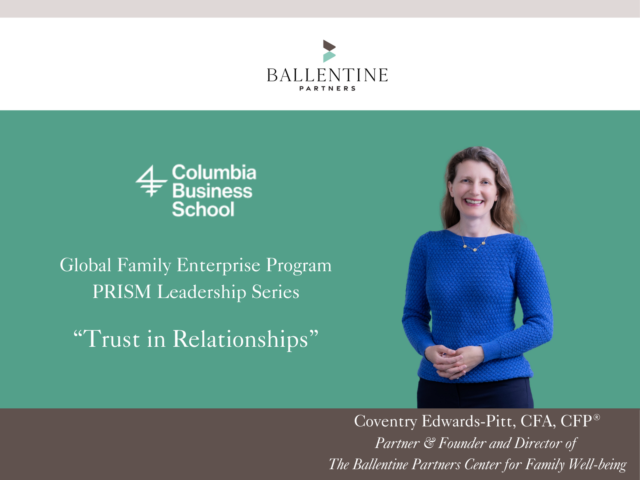As published in Investor Focus, Infovest 21, in October 2012.
Will Braman, Ballentine Partners
By JingLin Huang
Will Braman is a managing director and the chief investment officer at the firm. He is responsible for leading the investment team and managing the investment process. He has 30 years of experience in investment management, and more than 20 years in executive leadership roles within asset management companies.
Ballentine Partners, set up in 1984, is a multi-family office for high net worth individuals and families. They do both investment management and planning for clients. They have about 120 families as clients, many of which are entrepreneurs and in the investment business. The average client size is $50 million.
Infovest21: Describe your approach.
Will Braman: There is no typical portfolio per se but there is a common approach. We sit down with our clients and go through a full analysis of their goals and objectives. Depending upon if it is an entrepreneur who has sold his company and is still working, there will be a different goal than a second or third generation client who is looking more for preservation of capital. We seek to understand their needs upfront, their objectives, their risk tolerances and from there we construct a portfolio.
We pursue a modified endowment model that utilizes a variety of asset classes such as traditional and newer alternative and private asset classes. Because they are taxable, we use tax efficient structures such as ETFs for public equity because they are very tax efficient. We use active managers for private equity and hedge funds. We will make sure asset classes are in the right structures. If a client comes to us with tax-exempt assets such as a family foundation or IRA, we may tend to put the higher income distributing assets in those tax exempt funds and the more growth, capital gains oriented ones in the taxable funds.
Infovest21: Have there been changes to your asset allocation strategy? What percentage of your portfolio is in hedge funds, equities, bonds and private equity etc.?
Will Braman: For all our clients, we will come up with a strategic allocation plan with a range of allocations for the underlying asset classes. On top of that, we will also employ tactical asset allocation shifts over time when we think some asset classes have become undervalued or overvalued. Strategically, we have been moving toward greater use of hedged alternatives and real assets over the past several years as well as private equity. Each of our clients is unique, but here’s an idea of what the model portfolio looks like.
Today, 50% of the portfolio is in equity. Of that 50%, about to 6-8% is in private equity. Of the public equity, we are about 60% domestic, 25% developed international and 15% emerging markets.
Approximately one-quarter of our portfolio is in fixed income. With our clients in need of income, we might allocate 15% in intermediate duration municipal bonds, 5% in high yield and floating rate bonds and 5% in TIPS. That leaves 25%, of which 15% is in hedged alternatives evenly split between public liquid alternatives, managed futures and hedge funds and 10% in real assets such as US /international real estate, commodities and most recently energy related investments such as MLPs and energy private equity. We do real estate through public vehicles such as REIT ETFs and private limited partnership structures. Because so many of our clients already have significant real estate holdings, our portfolios generally have smaller allocations in that sector than what other investors may have.
Infovest21: What is the role of hedge funds in the portfolio?
Will Braman: When we think of hedge funds, we think broadly about absolute return-oriented strategies. We invest in hedge funds, funds of funds, public alternatives and managed futures. We do so because they can provide a source of absolute return with fairly low correlation to other asset classes as well as having lower volatility themselves. They provide downside protection in choppy market environments. We are looking to strategically increase our exposure to hedge funds through some differentiated strategies which would include private mezzanine loans, such as
small business administration (SBIC or Small Business Administration) loans, hedged commodity trading accounts, residential and commercial mortgage-backed securities funds, etc. These can generate an absolute level of return with a low level of volatility and low correlation to equities and fixed income in general.
Infovest21: Tell us about the SBIC loans.
Will Braman: They are typically small business loans with an implicit government guarantee; the loan funds will normally have a three-year life. You have the equivalent in non-implicitly government guaranteed funds that are more like corporate high yield and credit mezzanine loan funds. They have different risk profiles; the SBA loans have lower risk than the mezzanine loan funds.
Infovest21: How do you source managers?
Will Braman: We are known in the marketplace for using alternatives and are contacted by capital introduction firms, prime brokers and bankers. The best introductions we get come from our clients. About one-third of our clients are in the investment business, notably in real estate and technology. We also get some of our ideas from the funds of funds that we work with. We work with them openly. (Note: Ballentine does not have an internal fund of funds product.) Lastly, we belong to an industry group of like-minded family office groups called the 20/20 Group with which we regularly share ideas.
Infovest21: Where do you see opportunities in hedge funds?
Will Braman: Let me address the newer opportunities that our clients are currently adding to the portfolio. We look at the opportunities in energy in North America as a very good long term investment due to changes in drilling, finding and raising technology, which includes three-dimensional seismic, horizontal drilling and fracking. We see an opportunity for the US to become
an energy independent country in 20 years. That will require an enormous infrastructure build out, exploration and development. Our clients are adding exposures in two ways: through mid-market master-limited partnerships that own and operate pipelines and gathering and distribution networks. The other opportunity is an investment into a manager of exploration companies within a private equity fund with a 10-year life where they seed and develop small energy companies who find and prove reserves. This should be an interesting investment in the next 10 years.
Infovest21: What are some hedge fund managers you allocate to?
Will Braman: We do not disclose them except to clients.
Infovest21: Are there plans for new allocations?
Will Braman: We would like to increase our allocation to hedged alternatives from 15% to 20-25% over time. We are seeing lots of interesting strategies. We even had one of our analysts introduce us to an orange juice futures trader.
Infovest21: What is the asset size sweet spot?
Will Braman: For a single strategy hedge fund manager, the sweet spot is between $200 million to $1 billion. For funds of funds, it has to be bigger than that, probably $500 million to $3 billion. You have to have some scale and size to take positions in the underlying managers. We prefer finding idiosyncratic managers who are unique and have less money to move around. Some of these managers such as the SBA loan funds or mezzanine loan fund can be as small as $50 to $100 million. A mezzanine loan fund that is over $500 million is probably a difficult beast to be fully invested and up-and-running in three years. Smaller can be better, but not too small.
Infovest21: What is your investment horizon and target return/volatility?
Will Braman: The investment horizon is 10 years. It is a little more complicated than that because it depends on the client’s goals and objectives, as well as their lifestyle needs to generate current income. Our target returns vary. When we look at aspirational or growth assets, we are looking at emerging market equity, small and mid-cap equity, private equity and venture capital. Aspirational return might be 10% or more pre-tax.
We are in a low-return environment and we think we will be here for a while. That means lower than what we have seen historically, volatility higher than what we have seen historically and correlations higher than what we have seen historically. Assuming inflation at 2.5%, we like to give clients a net return after taxes and fees 2% to 3% higher than inflation. That really means a 6.5% to 7% pre-tax return. If the strategy calls for asset conservation, that might be around 4%. Portfolio volatility will range accordingly between 6-12% depending on a client’s strategic allocation.
Infovest21: Have there been any changes to your investment or due diligence process?
Will Braman: We are increasingly looking for non-correlated strategies. These require more creative thinking outside-the-box due diligence. We found the orange juice trader who also has a processing plant. It was very niche, but an interesting idea.
We are looking at how to best package and deliver these strategies to the client. Should we create an internal commingled vehicle? Should it be in a separately managed account? Are there ways we can put together these strategies to produce better risk-adjusted or tax-adjusted profiles?
We use broadly the same set of managers in the investor portfolios. Managers we employ will be on an approved list and regularly reviewed by our analysts.
Infovest21: What is your outlook for family offices investing in hedge funds?
Will Braman: Family offices are going to look for differentiated sources of absolute return. The experience in 2008 of a large drawdown was shocking to many managers let alone their clients. The basic long/short hedge fund did not offer a lot of protection. Family offices are increasingly looking to hedged solutions or hedge fund structures, differentiated from long/short equity or long/short credit.
Learn more about Will Braman, Chief Investment Officer.




